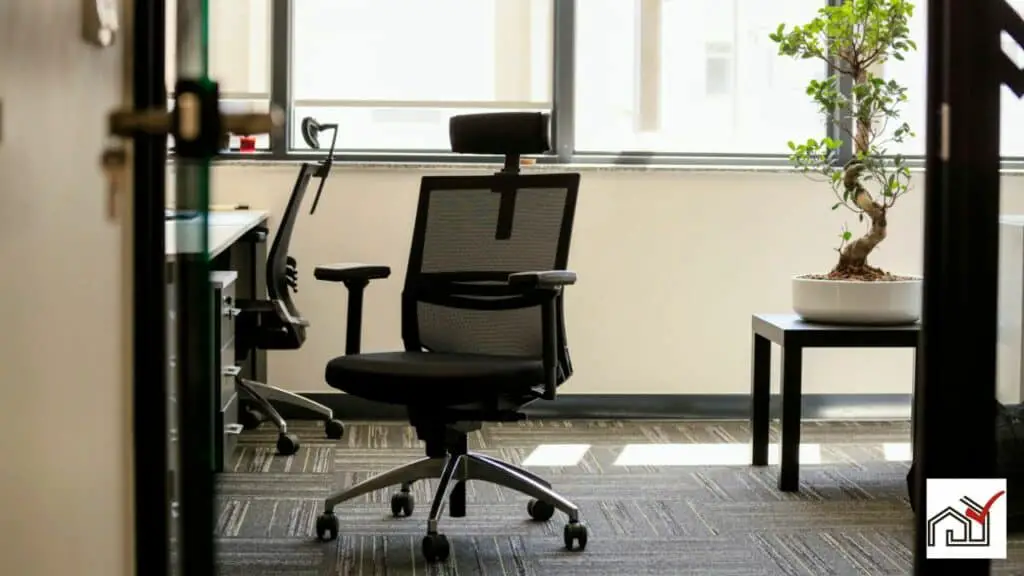An office chair that leans back improperly can affect comfort and work, leading to bad posture and back pain.
To fix this, identify the cause, which could be a broken tilt mechanism, loose parts, or a faulty gas lift.
Inspect the chair, adjust or replace parts as needed, following the manufacturer's instructions.
Tighten all parts and set the tension correctly to make the chair function properly again, improving the seating experience.
Identify the Issue
To fix an office chair that leans back too much, begin by inspecting the seat for damage. If the seat is fine, check for loose screws or bolts in the seat, backrest, or tilt mechanism, and tighten them with a screwdriver.
If the chair still leans back, the tilt mechanism might be faulty and may need adjustment or replacement. Worn-out wheels or casters, or a damaged gas lift cylinder, can also cause leaning.
If this is the case, replace these parts to correct the chair's balance.
Tighten Loose Components
To fix an office chair that leans back too much, start by checking for loose screws or bolts on the seat and backrest. Secure any loose parts to ensure the chair's stability.
Turn the chair to its side or upside down to access the underside of the seat where the seat plate is located. Look for loose screws or bolts and tighten them with a screwdriver or an appropriate tool, being careful not to over-tighten and cause damage. Replace any missing screws with the correct size and type.
After tightening everything, return the chair to its upright position and test it by sitting and leaning back to make sure the issue is resolved. If the problem persists, further examination of the tilt mechanism or other parts may be needed.
Regular maintenance, including checking and tightening screws and bolts, is essential to keep an office chair in good condition and prevent excessive leaning.
Adjust Tilt Tension
After securing all parts of the chair, adjust the tilt tension to prevent the chair from leaning back too much. The tilt tension mechanism determines how much resistance you feel when leaning back. This is usually adjusted by a knob or lever under the seat.
To adjust, find the tilt tension control and turn the knob clockwise to increase resistance, making it harder to lean back. Turn it counterclockwise to decrease resistance for easier reclining. If your chair has a lever, follow the manufacturer's instructions to adjust it.
Aim for a comfortable resistance level that matches your body weight and comfort. Test the tilt by sitting in the chair and leaning back after each adjustment. If the chair leans back too easily after tightening, you may need to increase the tilt tension.
Do not set the tension too low or too high, as this can cause the chair to recline too easily or make it difficult to lean back. Regularly check and adjust the tilt tension since it can loosen over time with use. Proper adjustment ensures your chair supports you comfortably during work.
Inspect Gas Lift Cylinder
Inspect the gas lift cylinder if your office chair leans or doesn't stay at the set height. Use the height-adjustment lever while seated. If the chair lowers or won't lock in place, the cylinder might be faulty.
To examine the cylinder, stabilize the chair and secure any loose parts. Remove protective covers for a clear view of the cylinder. Look for scratches, dents, or grease leaks, which suggest damage. If there's no visible damage but the chair still malfunctions, the cylinder likely needs replacing.
Find the right replacement cylinder, matching the model and size, from an office supply store or online. With the appropriate cylinder, you can continue with the repair.
Evaluate Wheels and Casters
After examining the gas lift cylinder, evaluate the office chair's wheels and casters for issues that could cause leaning. A chair that leans excessively may indicate problems beyond the gas lift cylinder, such as defective wheels and casters. If the chair feels unstable or tilts when seated, a detailed check of these parts is necessary.
First, inspect the chair from both an upright and an upside-down position to ensure a thorough examination of the wheels and casters. Look for any that are bent or misshapen, as these can offset the chair's balance and hinder proper posture. Replace any damaged or distorted casters.
For replacements, obtain a matching set from an office supply store to guarantee the chair rolls smoothly. Even if only one caster is damaged, it is recommended to replace all casters to ensure even performance and stability.
If the chair continues to lean and the casters are intact, the seat plate might be the issue. Inspect it for damage or wear and check that all connections are secure. If the seat plate is loose or damaged, it may need tightening or replacement to resolve the leaning problem.





